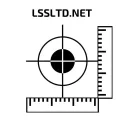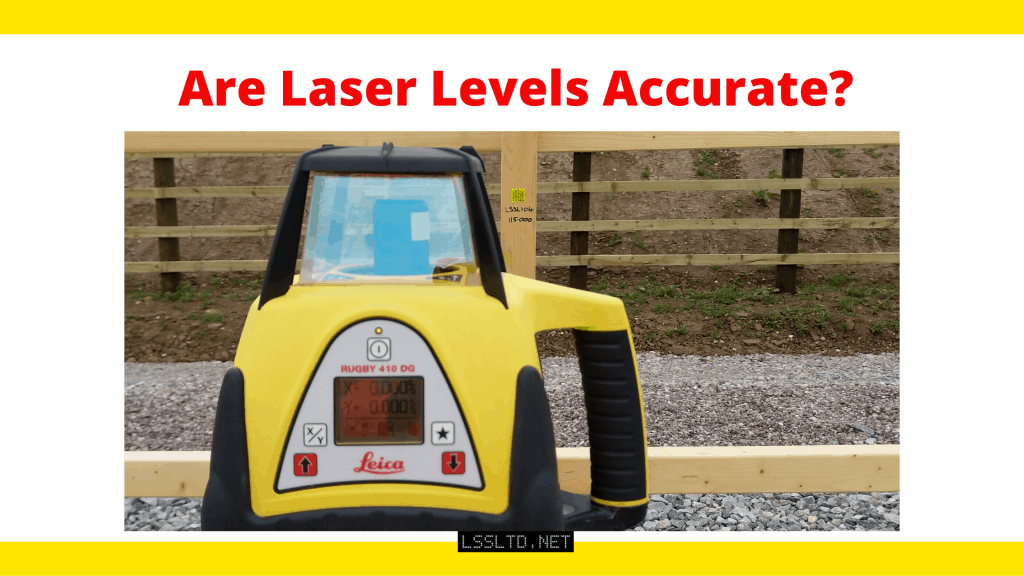Are Rotating Laser Levels More Accurate than Claimed?
I have often said in review articles about rotating laser levels that I find them to be more accurate than the quoted figures from the manufacturers. These comments are based on my experience using some of the best rotating laser levels that are available for use on construction sites. Experience that has been over numerous years using not only rotating laser levels, but all types of surveying equipment.
It is extremely easy for me to say these things on this website and hope that you take my word for it. So, I thought I would demonstrate the accuracy of a rotating laser level.
But first, lets have a look at the most accurate rotating laser levels currently available on the market today. Below is a table of rotating laser levels ranked in order of accuracy.
| Manufacturer | Model | Working Range (Diameter) | Accuracy | Working Time (Single Charge) | Current Price (Amazon) |
| Topcon | RL-200 | 1100 | 4mm at 200m | 100Hrs | |
| Topcon | RL-H5A | 800 | 5mm at 200m | 100Hrs | |
| Topcon | RL-SV2S | 800 | 5mm at 200m | 120Hrs | |
| Topcon | RL-H5B | 400 | 10mm at 200m | 100Hrs | |
| Leica | Rugby 680 | 900 | 1.5mm at 30m | 60Hrs | |
| Spectra Physics | LL300S | 800 | 1.5mm at 30m | 60Hrs | |
| Bosch | GRL 500 HV | 500 | 1.5mm at 30m | 25Hrs | check current price |
| Johnson | 40-6584 | 600 | 1.6mm at 30m | 100Hrs | |
| Johnson | 40-6541 | 500 | 1.6mm at 30m | 33Hrs | |
| Johnson | 40-6535 | 500 | 1.6mm at 30m | 33Hrs | |
| Leica | Rugby 610 | 500 | 2.2mm at 30m | 60Hrs | check current price |
| Leica | Rugby 620 | 600 | 2.2mm at 30m | 60Hrs | check current price |
| Leica | Rugby 640G | 400 | 2.2mm at 30m | 60Hrs | |
| Leica | Rugby 640 | 500 | 2.2mm at 30m | 60Hrs | check current price |
| Spectra Physics | LL300N | 500 | 2.2mm at 30m | 90Hrs | check current price |
| Fukuda | FRE-102AR | 600 | 2.3mm at 30m | 25Hrs | |
| Johnson | 40-6950L | 450 | 2.4mm at 30m | 16Hrs | |
| Makita | SKR200Z | 200 | 3.0mm at 30m | 60Hrs | |
| Spectra Physics | LL100N | 350 | 3.3mm at 30m | 50Hrs | check current price |
| Pacific | HVR 505R | 152 | 3.3mm at 30m | N/A | |
| Stabila | STB-LAPR150 | 240 | 6.0mm at 30m | 80Hrs | |
| Hilti | PR 2-HS A12 | 600 | N/A | 16Hrs |
Disclaimer: This site, and in particular this page, contains affiliate links to products. You are under no obligation to but if you visit and buy something from their site from a link on this site, we will receive a small commission, the price you pay will remain the same. This helps to keep this website running and your help is appreciated.
How the Rotating Laser Level was chosen for the test.
I did not get to choose the rotating laser level for this test. It was hired for a large construction site. I had no influence in the choice of the rotating laser level that would be used on the site. So, this is a completely random rotating laser level. But I did need to know that it was accurate enough to be used on site.
Every Engineer or Surveyor should be able to check the accuracy of the measurement equipment they are using. To demonstrate the accuracy of the rotating laser levels I am using a recently hired Leica Rugby 410 dual grade laser. This rotating laser level was hired from SCCS. This meant that the rotating laser level that I am using is completely arbitrary.
How to check a Rotating Laser Level.
There is a set procedure for checking the accuracy of rotating laser levels. What we are wanting to know is that the level is as accurate as the manufacturers specify it should be. There is a complete, easy to follow, procedure for checking rotating laser levels her on this website. You can read how to check a rotating laser level here.
I am going to be checking this rotating laser level, but not in the stated way in the guide for checking a rotating laser level. I am going to be setting up a long level base line to check the accuracy of this randomly selected Leica Rugby 410 dual grade laser.

How to establish a Level Base Line for Checking Levels.
Part of what I do on construction sites is setting up primary control for the works to be measured from. And then working on sites during the construction phase of the works I found it particularly useful to have a level baseline to check instruments against. This is something I learnt from having to establish the 1m Above Finished Floor Level Marks when building large warehouses.
Setting up Primary Control on any site needs a methodical approach and a lot of care. The approach taken should minimise the errors in the primary control points. For more information on how to setup primary control on construction site this article would be well worth a read. Primary Control Surveys are Critical to Success.
The current site I am working on has a large compound. It measures about 160m by 60m. Using a Leica TS16 Robotic Total Station I set up 4 Retro Control Stations on each of the 4 sides of the fencing that surrounded the compound. I set all four retro targets to the same elevation on each post. Deciding on a height of 115.000m. I took create care in setting these, first marking what I thought was the correct height, then checking, then adjusting until I was happy with the level that I could stick on the retro target. The whole process took a good couple of hours to complete.
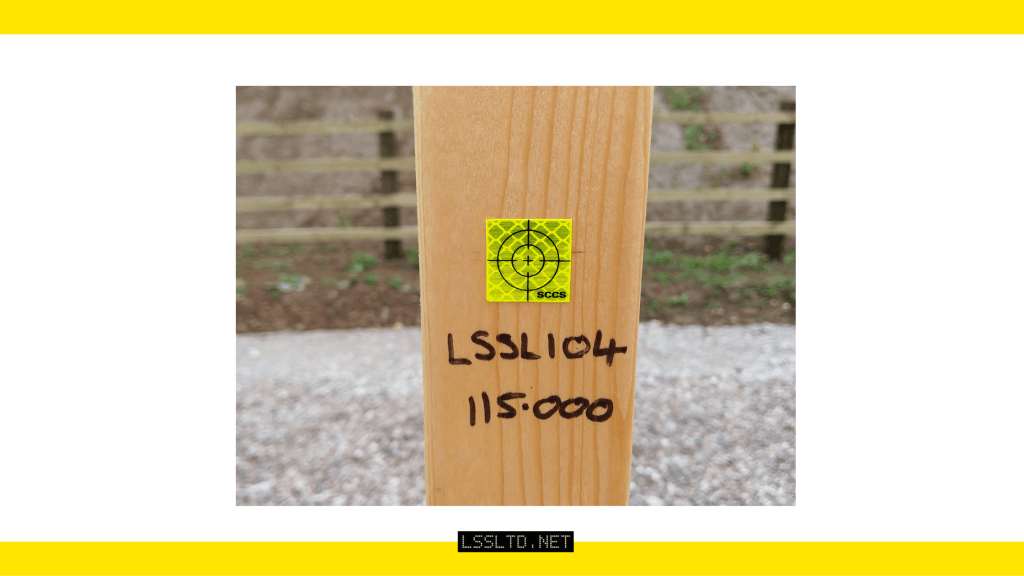
Once I had the four retro targets set, I checked them a couple of times. I did this by setting up the Leica TS16 Total Station a couple of times in different locations and surveyed the retro targets once more to check their level was within 1mm of the desired 115.000m level.
This means that I now have a level base line that I have confidence in and that I can use to check any rotating laser level that I might need too.
Setting up the Rotating Laser Level.
For this test, I setup the Rotating Laser Level so the laser beam is at the 115.000m level. This takes some time to achieve accurately. But it does make checking the rotating laser level much easier later on. I have set the Leica Rugby 410 Dual Grade Rotating Laser Level to be horizontal, that is I have both grade readings set to 0.000%.
For setting the rotating laser level to the correct height I first set the tripod to roughly the level I think will be correct. Then set the laser level on the tripod and switch it on and allow it to self-level. I then check to see what height I have the laser level set to against my benchmark. Using the Rod-Eye receiver I then get a measurement of how far from the benchmark level the rotating laser level is. I will then adjust the tripod by either extending or shortening the legs by equal amounts. I then switch the rotating laser back on, allow it to self-level and once more take a measurement to the benchmark. I keep repeating this until I have the rotating laser level at the same height as the benchmark. This process can take some time and is best performed close to a benchmark.
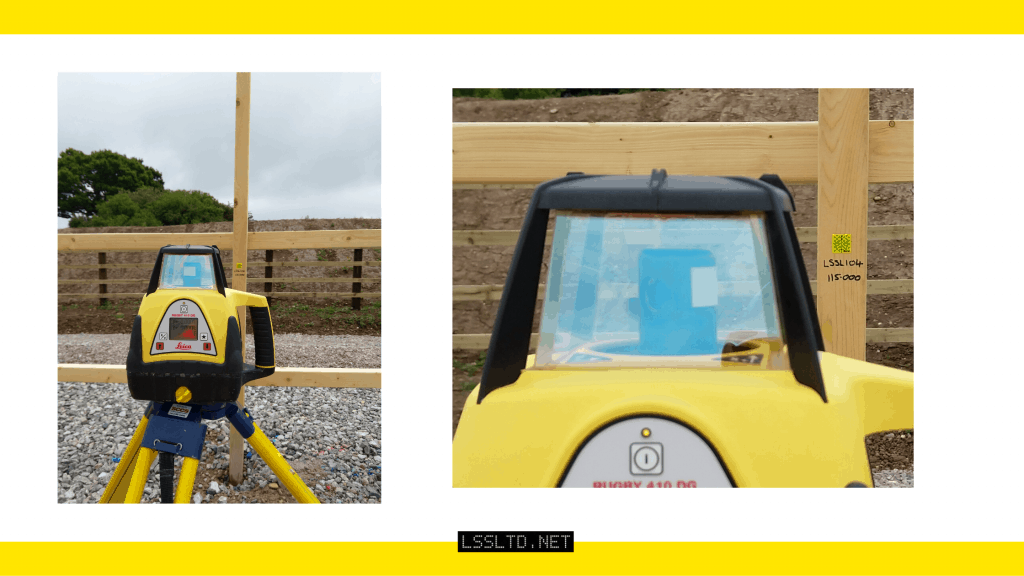
You can make this operation easier and quicker by using a telescopic tripod. Like this Bosch one I found on Amazon.
Once the Rotating Laser Level is Set to the Correct Height.
Now that I have the rotating laser level set to the correct height for this test, I can then check the accuracy against another point. I know that the collimation height of the rotating laser level in this case is set to 115.000m.
I first place the laser receiver against the closest level point to check the height of the laser beam. In the picture below you can see that the reading is 0mm, therefore the laser detector is at the same height as the known point. In this case the height is 115.000m. This control station is called LSSL104. You can see that I have taken great care in setting up the rotating laser level to this height and that it is close (within a couple of metres) of control station LSSL104.

For this test I have been using the Leica Rod-Eye 160 receiver. This receiver is the most accurate receiver currently available from Leica for use with rotating laser levels. The Leica Rod-Eye 160 has a setting that allows measurement readings to 0.5mm. This is the setting I have been using to setup the Leica Rugby 410 rotating laser level and completing this test.
Checking the Accuracy of the Rotating Laser Level.
Now that I have the Leica Rugby 410 Rotating Laser Level set at a collimation height of 115.000m, I can now check the accuracy of the laser level. I have the rotating laser level set very close to my known datum point. Any error that this rotating laser level may have should be negligible when measured at this first control station, LSSL104.
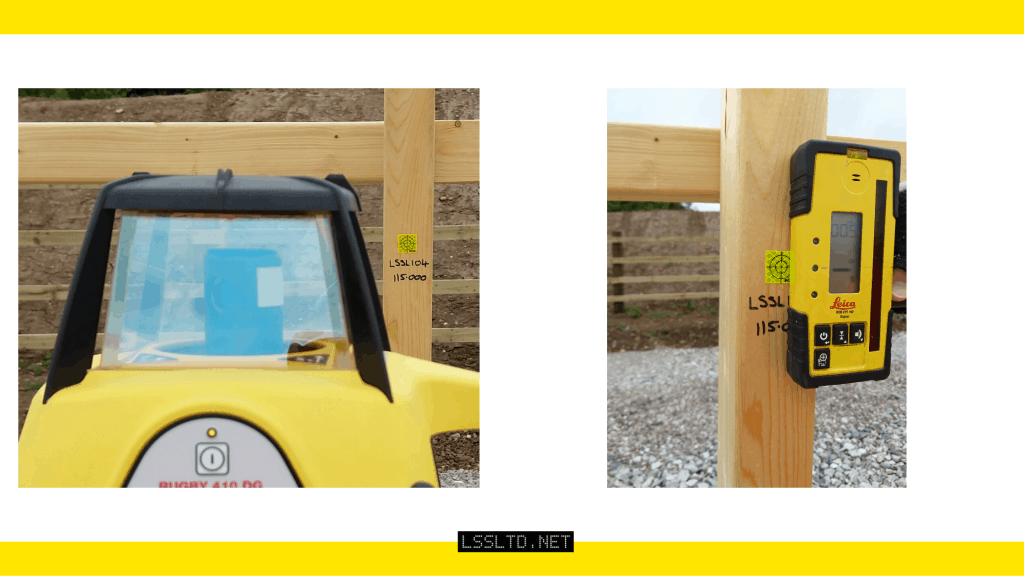
Moving away from the rotating laser level, any error that may be present will be magnified the further I am away from the rotating laser level. By having unequal linear measurement distances, I can find the error of the rotating laser level. This is the basis of any two-peg test for any levelling equipment you might have.
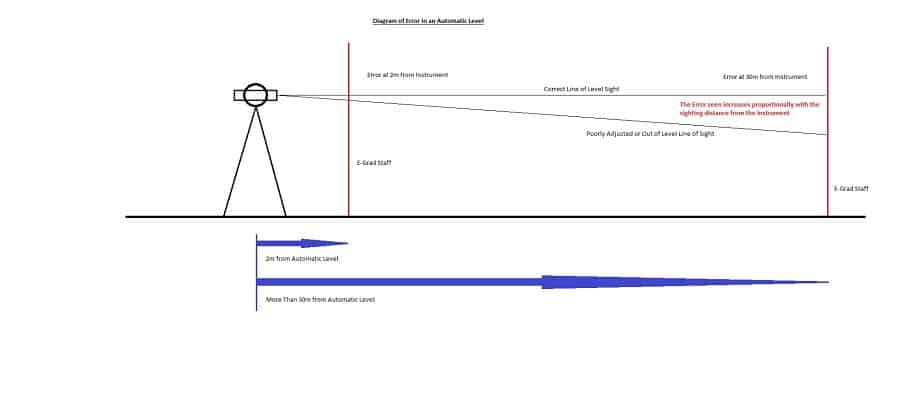
What Accuracy should the Leica Rugby 410 rotating laser level have?
The quoted accuracy for the Leica Rugby 410 rotating laser level is ± 1.6mm per 30m. To be able to test whether this rotating laser level I have is that accurate I need to be able to measure the height difference at least 30m away from the rotating laser level. As I have two known points at over 30m apart, I can calculate the accuracy of this rotating laser level.
The two control stations that I will be using.
I have setup around the site numerous control station points for the accurate setting out of the proposed works. Several of these control stations have been set at the same level. This enables me to quickly check any levelling equipment that may be used on site.
The two control points that I am using for this test are LSSL104 (115.000m) and LSSL102 (115.000m). The distance between these two points is 157.195m. This is going to be the length of the base line that I cam going to be checking the accuracy of the rotating laser level over.
Taking a reading at LSSL102
Now that I have the rotating laser level set at the height of collimation (115.000m) that I want, I can now measure the height of the laser beam at the control station LSSL102. If the rotating laser level has no error in level, then I should get a reading of 0mm at LSSL102. But nearly every rotating laser level will have some inaccuracy, so I am not expecting to see a reading of 0mm.
What Reading should I expect to get with this rotating laser level?
With the Leica Rugby 410 rotating laser level quoted accuracy then I should expect to get a reading less than 8.5mm above or below LSSL102. This is because the quoted accuracy is ±1.6mm per 30m, or ±0.053mm per 1m, or ±8.53mm at 160m.
What reading did I get with this rotating laser level?
As can be seen in the photo, the reading at LSSL102 is 5.5mm above the target. This is within the quoted accuracy for the Leica Rugby 410 rotating laser level. To be able to compare this with the quoted Leica accuracy figures we need to do some maths. For ease of calculation I am going to say the distance that the rotating laser level was checked was only 150m. I need to divide the height above LSSL102 figure by the distance figure. 5.5mm divided by 150m. This give me a figure of 0.0366mm for every metre. This is equivalent to ±1.1mm per 30m.

Are Rotating Laser Levels More Accurate than Quoted?
Yes, they are. In this case they are about 30% more accurate than the quoted figure. This is often the case I find with rotating laser levels.
What this also shows is that rotating laser levels are very accurate pieces of equipment, and if used carefully they can yield very accurate results. As with most of the top brand rotating laser levels you can achieve levels within a few millimetres over distances of 300m (150m radius from the rotating laser level).
Which are the most accurate rotating laser levels currently available?
Let me take this chance to show this table I created, ranking the rotating laser levels in their order of accuracy. These are rotating laser levels that you can currently buy from most retailers.
| Manufacturer | Model | Working Range (Diameter) | Accuracy | Working Time (Single Charge) | Current Price (Amazon) |
| Topcon | RL-200 | 1100 | 4mm at 200m | 100Hrs | |
| Topcon | RL-H5A | 800 | 5mm at 200m | 100Hrs | |
| Topcon | RL-SV2S | 800 | 5mm at 200m | 120Hrs | |
| Topcon | RL-H5B | 400 | 10mm at 200m | 100Hrs | |
| Leica | Rugby 680 | 900 | 1.5mm at 30m | 60Hrs | |
| Spectra Physics | LL300S | 800 | 1.5mm at 30m | 60Hrs | |
| Bosch | GRL 500 HV | 500 | 1.5mm at 30m | 25Hrs | check current price |
| Johnson | 40-6584 | 600 | 1.6mm at 30m | 100Hrs | |
| Johnson | 40-6541 | 500 | 1.6mm at 30m | 33Hrs | |
| Johnson | 40-6535 | 500 | 1.6mm at 30m | 33Hrs | |
| Leica | Rugby 610 | 500 | 2.2mm at 30m | 60Hrs | check current price |
| Leica | Rugby 620 | 600 | 2.2mm at 30m | 60Hrs | check current price |
| Leica | Rugby 640G | 400 | 2.2mm at 30m | 60Hrs | |
| Leica | Rugby 640 | 500 | 2.2mm at 30m | 60Hrs | check current price |
| Spectra Physics | LL300N | 500 | 2.2mm at 30m | 90Hrs | check current price |
| Fukuda | FRE-102AR | 600 | 2.3mm at 30m | 25Hrs | |
| Johnson | 40-6950L | 450 | 2.4mm at 30m | 16Hrs | |
| Makita | SKR200Z | 200 | 3.0mm at 30m | 60Hrs | |
| Spectra Physics | LL100N | 350 | 3.3mm at 30m | 50Hrs | check current price |
| Pacific | HVR 505R | 152 | 3.3mm at 30m | N/A | |
| Stabila | STB-LAPR150 | 240 | 6.0mm at 30m | 80Hrs | |
| Hilti | PR 2-HS A12 | 600 | N/A | 16Hrs |
